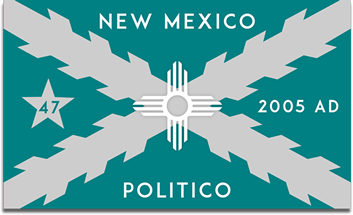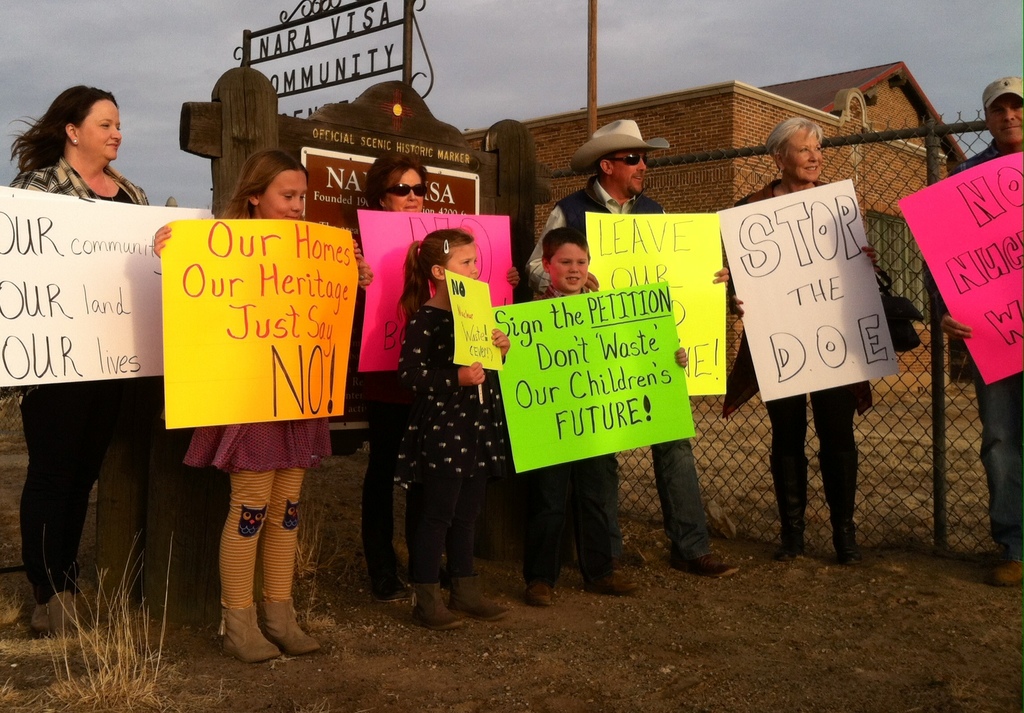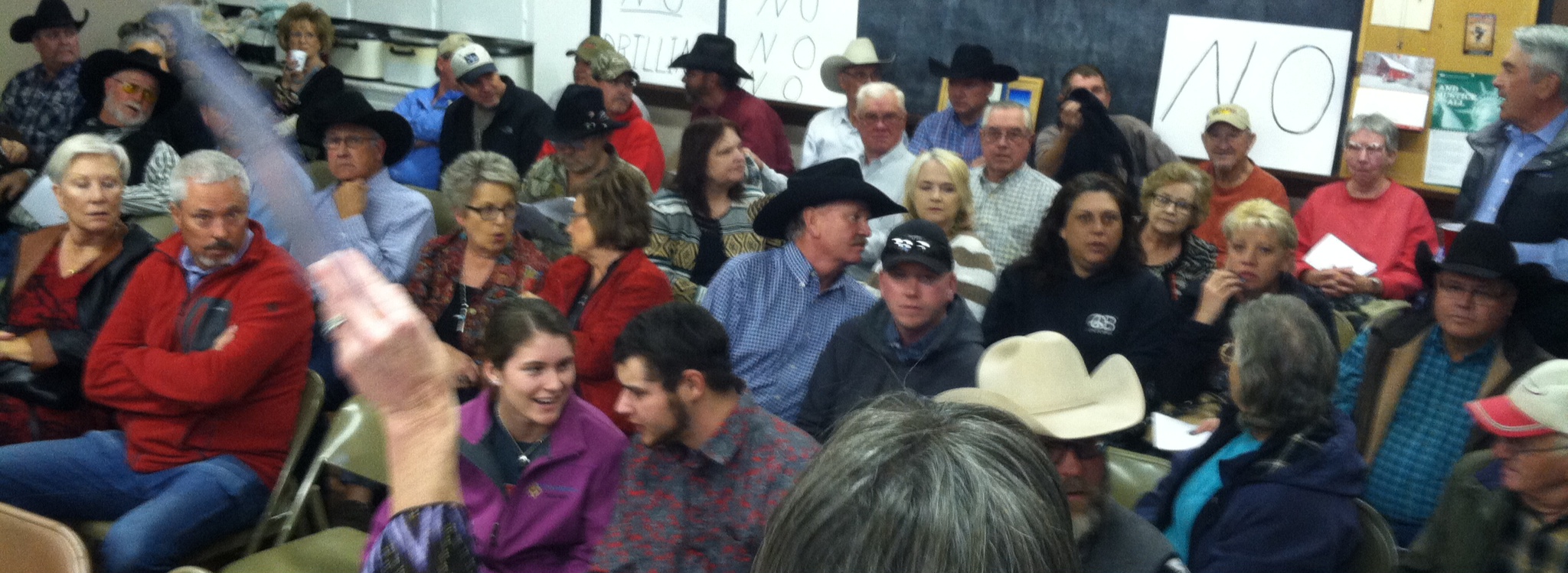“As I see it, we’ve got to put this stuff somewhere,” explains Marc Eckels, project manager for Atlanta based ENERCON and DOSECC Exploration Services, referring to the public need to store high level nuclear waste.
Rancher and agricultural engineer Ed Hughs, born and raised in Nara Visa, minced no words in response. “Not here. I will fight you on this until the day I die.”
Hughs and about 70 other Quay county residents recently attended a January 30, 2017 County Commission meeting in Tucumcari to discuss ENERCON’s push to drill a three mile deep borehole in Nara Visa. According to Eckels, the drilling of the deep borehole is “nothing more than a feasibility study” needed to research the geophysical conditions for nuclear waste storage in Nara Visa.
To alleviate resident concerns, ENERCON hosted a follow-up meeting last night (February 7th) at the Nara Visa community center. The number of residents attending the follow-up meeting increased threefold to about 170 individuals. To put that in perspective, the entire population of Nara Visa is about 50 people. At one point, residents had to relocate to the main auditorium, with many still left standing, or having to find seats in the balcony area.
The evening started with a protesting contingent that met outside the community center hours before the meeting’s start time. Residents spoke with a ABC 7 News reporter all the way from Amarillo, Texas, investigating concerns over the impact of drilling and any potential contamination of the Canadian River, a water source shared by each state. Attendees arrived from five nearby counties, concerned that a potential radiation leak could affect a population radius of up to 50 miles away from the proposed drilling site.
ENERCON outreach coordinator Chip Cameron began the meeting trying to reassure residents, stating that no nuclear waste would be stored in the proposed 8 inch in diameter borehole. He also promised that the community could expect many benefits to include private STEM funds, construction jobs, and much needed tax revenue to the area. Project manager Mark Eckels followed up, providing a power-point presentation on the drilling process, and touted what he thought the benefits of the 30-40 million dollar project were; claiming that students and residents could take tours of the drilling site.
At the close of Eckels’ presentation, it was abundantly clear that residents were not persuaded by Eckels or Cameron’s promises.
With research binders and Department of Energy (“DOE”) materials in hand, Ed Hughs set the tone for the night:
“We don’t disagree with Mr. Cameron that, per the contract, nuclear waste will not be stored in the 8 inch diameter borehole, nor the second 17 inch characterization borehole.
Our primary concern, one that Mr. Cameron and ENERCON can’t alleviate, is that if the site is found suitable, and the Nara Visa location is the only suitable location in the United States after a 40 million dollar investment, then this site will be subject to subsequent boreholes and will be well on its way to becoming a nuclear repository site.”
The NMP asked Hughs for sources that confirmed his contentions, and he immediately provided two reliable sources. The first source was a complete contract for the deep borehole project from the DOE. The contract contains property use provisions outlining later phases of the deep borehole project, which includes language that the “US Government, at its sole discretion… [has] the right to further test, drill and/or improve the characterization deep borehole and to drill one or more additional deep borehole(s) of differing sizes and configurations on the site for additional research purposes.”
Hugh’s claim that the DOE can drill more than one hole checks out. But what about Hugh’s contentions concerning the potential storing of nuclear waste? Hughs then directed me to his second source, a copy of the DOE’s Draft Plan for a Defense Waste Repository, published December 2016.
After review of the DOE’s plan, Hugh’s fears are clearly confirmed.
The DOE’s plan states in part:
“[s]ubsurface investigations from boreholes…provide the necessary information to support detailed repository design and preparation of an [environmental impact statement]. Assuming the site is found suitable, site characterization ends when a license application seeking authorization to construct the facility is submitted to the NRC…. Receipt and disposal of radioactive waste will require a license to receive and possess waste to begin disposal operations.”
All that is required after ENERCON’s research project, is application seeking authorization. It is clear that Cameron and Eckels are attempting to focus Quay county residents’ attention on only a singular phase of ENERCON’s involvement, rather than the DOE’s larger plan to construct a facility at a suitable site. Unfortunately, several media publications have adopted ENERCON’s narrative that there is no chance of nuclear waste storage, and that the deep borehole project is nothing more than a feel good story about lifting a depressed economic region out of poverty. Unfortunately, it’s a narrative without any meaningful investigation.
ENERCON’s approach is smart, yet highly unethical. It provides Cameron and Eckels plausible deniability with residents, allowing them to claim willful ignorance that ENERCON’s research could inevitably open the door to justify the DOE’s application and approval for a license to receive and possess nuclear waste in Nara Visa.
As an editor and legal analyst for the New Mexico Politico, let me attempt to clarify the unspoken proposition contained in Hugh’s sources more clearly.
In no uncertain terms, ENERCON’s science project will provide ammunition to the DOE in its ability to exercise eminent domain over lands in Nara Visa.
For those that may not understand eminent domain, the Fifth Amendment to the Constitution recognizes the preexisting power of governmental entities, like to the DOE, to take private property for public use provided there is just compensation. This power supersedes private contract rights. Recall Marc Eckel’s words concerning the public need to store nuclear waste:
“As I see it, we’ve got to put this stuff somewhere.”
Reading between the lines, somewhere is Nara Visa.
II. How did Nara Visa get into this predicament?
In late September of 2016, ENERCON President of Federal Services, Peter Mast, met with about 45 Quay county residents. And during a October 10, 2016 board meeting with Quay County Commissioners, Mast presented Resolution No. 27, a request that the commissioners support ENERCON’s drilling of a deep borehole to test nuclear storage capabilities.
The Commission approved Resolution No. 27 based on Mast’s representation that the 45 individuals that attended his meeting were “very supportive.” A subsequent email from Mast to the Commission thanked them for their approval of Resolution No. 27, claiming the support garnered by the public was “instrumental in [the] DOE’s decision” in awarding ENERCON with their multi-million dollar contract.
The problem with Mast’s representation to the Commission is that it’s false. Rancher Jim Valentine was at the 45 person pre-resolution meeting. Valentine could recall only a few people indicating interest in the project.
In fact, Valentine confronted Mast during last night’s meeting. Shockingly, Mast did not dispute Valentine’s claim that Mast’s version of “community support” accounted for only 5 individuals expressing interest.
Last night’s meeting also revealed that at least 2 of the 5 persons indicating interested in ENERCON’s project, stand to financially benefit from it. Nara Visa local, Lewis James, and his wife, are in the midst of negotiating a contract to lease some of their land to ENERCON in exchange for financial compensation.
When pressed further by Valentine for an explanation of his misrepresentations to the Commission, Mast was evasive, providing a shoulder shrug, and stating that the other 40 persons present during September meeting “did not say they were against the project….”
County Commissioner Sue Dowell was asked by members of the audience if she consulted with any members of the public before casting her vote. Specifically, she was asked whether she relied on anything but Mast’s assessment of public support. Dowell declined to respond.
Ed Hughs and others contended there was no meaningful outreach from ENERCON or from the County Commission before the Commission voted on Resolution 27, stating that “not a single adjoining property holder to the borehole site was contacted.”
Several other residents expressed their frustration that the September meeting with Mast was not a meeting subject to the New Mexico Open Meetings Act, and that the Commission’s exclusive reliance on ENERCON lacked the due diligence becoming a representative body. Under the Open Meetings Act, a Commission meeting would have been required to take minutes describing the proceedings, as well as make available to the public, an agenda 72 hours in advance.
Valentine’s distrust of Mast was palpable, saying, “[i]f we can’t trust you on the small things, how are we supposed to trust you on the larger issues?”
To avoid any further misrepresentations from Mast concerning the perception of overwhelming community support, resident Sandy Vaughn requested a show of hands from the 170 person max capacity crowd, to signal whether they opposed the project.
The vote against the borehole research project was nearly unanimous.
Nevertheless, it was clear that ENERCON representatives were not swayed by the public’s near unanimous opposition, with Mast suggesting that ultimately ENERCON would proceed with the drilling project upon approval from the Department of Energy. The only hurdle to the DOE providing the go-ahead, regardless of what the 170 residents expressed last night, would be the County Commission rescinding Resolution 27.
The New Mexico Politico will continue to follow the Nara Visa deep borehole story and investigate ENERCON’s claims concerning the economic benefits promised by their representatives in a story to be published later this week.
(Disclosure: My wife is related to the owners and operators of the Hat T Ranch in Nara Visa.)




